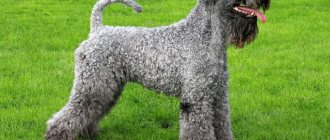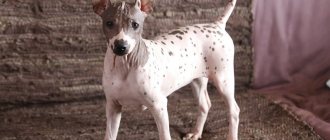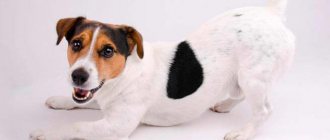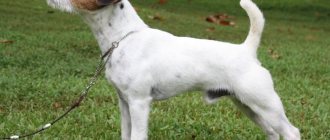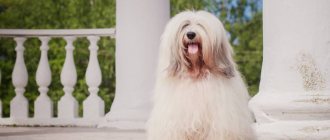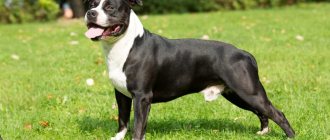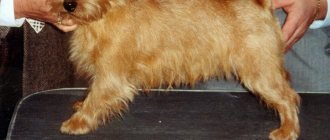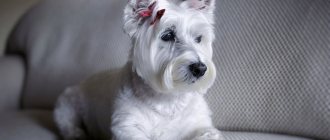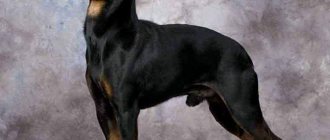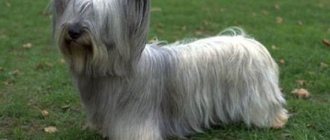The Czech Terrier is a friend, hunter, watchman!
In the middle of the last century, a Czech specialist who was involved in breeding dogs developed the “ Czech Terrier ” breed. Individuals of this breed are distinguished by hunting and guarding abilities. In addition, these dogs are very cute and friendly.
Interesting facts about the Bohemian Terrier
All Czech Terrier puppies are born black and only by six or seven months do they develop their final color.
Appearance
The official description of the breed presents the Czech Terrier as a comfortable dog in every sense. These unusual, short-legged dogs are successfully trained to work, and their physique is only a plus for hunting in a hole. Short legs do not in any way affect the physical strength and anger of the Czech Terrier, therefore, if necessary, he is trained to work on the ground (badger, fox).
Visually, females are a little more refined and elongated than males, but this difference does not affect physical strength and strength. Males are distinguishable by their muzzle and look. The dimensions of dogs vary within the same limits regardless of gender:
- Height: 27–30 cm.
- Weight: 6–9 kg.
Convenience in the compactness and versatility of the breed. According to the standard, the Czech Terrier is a small pet, agile, active, persistent, but not wasting energy. Despite the stockiness, the body composition is very harmonious and proportional, with the exception of height.
Disadvantages of the breed
Czech Terriers are not considered a common dog breed. For the breeder this sometimes causes inconvenience.
Czech terriers are distinguished by excellent health, but from their Scottish ancestors they inherited a disease - Scotty Crump syndrome. The meaning of the disease lies in the convulsive state into which the dog falls. Periodic manifestations of seizures affect the terrier's coordination, but are not considered a fatal disease. The contractions quickly pass, and the dog continues to behave in its usual way. However, for the owner, each attack becomes an additional dose of stress.
Attitude towards animals
Often people who purchase a Czech Terrier already have other pets at home. These could be dogs or cats. “Czech” treats them friendly and regards them as his comrades with whom he can frolic. Therefore, we can say that representatives of this breed are non-conflicting. If there is a quarrel between other animals, the Czech Terrier will prefer not to be a participant in it and will watch the situation on the sidelines. But do not forget that this breed was bred as a hunting breed, so the dog perceives all kinds of rodents as prey and can harm and even strangle them.
Breed standard
- The head is rectangular, the muzzle is wedge-shaped, the silhouette is emphasized by a beard and eyebrows, the back of the head is convex. The forehead is not wide, almost flat, slightly tapering. The transition is marked and separated by a groove. The bridge of the nose is elongated and smooth. The brow ridges are not clearly expressed, but are emphasized by the coat. The cheekbones are developed and fit harmoniously into the silhouette. Both jaws are fully developed, moderately wide and strong. The lips are not dry, but elastic and not saggy.
- The teeth are large, in the correct bite, the incisors are in line.
- Nose – black, brown or light brown, proportional.
- The eyes are small, blue set, well covered with eyebrows. The look is measured, not defiant, attentive. The color of the irises ranges from rich brown to light hazel depending on the coat color. The eyelids are tight-fitting, dry, colored to match the nose.
- The ears are triangular, medium-sized, set high, lowered to the head. Movable on cartilage, refracted in the first third. The rounded tips of the ears are adjacent to the cheekbones, the auricle is completely covered.
- The body is strongly built and squat. The neck is of proportional length, wide, oval, set harmoniously at an angle of 45°, the scruff is not pronounced, there are no folds, although the skin is not dry. The body is not too long, proportional, the back is straight and wide, the withers are powerful. The chest is oval, well elongated, voluminous, descending to the elbows or slightly below. The ribs are rounded, easily palpable, extended towards the groins. The loin is very muscular, the croup is very strong, neat, sloping. The belly is not dry and should not interfere with rapid movements.
- Limbs – Unlike most short-legged dogs, the Czech Terrier's limbs should be straight. When moving, the dog quickly throws out its paws, and the amplitude should not be sweeping. The front legs are straight, the bones are large, visually, the legs look powerful. The shoulder blades are pressed to the body, but are free to move, the shoulders are well muscled, the elbows do not rub against the body, they are directed strictly back, not tucked in, not turned out. The hind legs are set wider than the front legs and pulled back, the bones are powerful. The thighs are muscular, not too long. The shins are elongated, set at a harmonious angle. Due to the shortened shins, the hock joints are slightly elevated, directed only back. The hands of the front paws are larger than those of the hind paws. The paw pads are large and convex. The claws are strong, curved, pigmentation is not important, but should be in harmony with the color.
- The tail is thick and long in comparison with the body. Set on almost in line with the back or slightly higher. Carries freely, in a state of excitement - above the line of the back, slightly curved.
Coat type and color
The skin of Czech Terriers should not be too tight, but folds are not allowed. With good care, the guard hair has a characteristic, healthy shine. Throughout the body the coat is very dense, even, wavy and even curled. Light coats are softer and have a slight wave; dark hairs are longer, coarser and can curl.
History of the origin of the Czech Terrier
The glory of breeding the Czech terrier, which was once called the Bohemian, belongs to Frantisek Horak. He spent all his childhood years in the castle, but this man was not an aristocrat. He lived there because his father, grandfather and great-grandfather served there as simple hounds and grooms. This is where the boy's love for dogs came from. Growing up, he became interested in breeding Scottish Terriers and achieved outstanding results. He became one of the best breeders in Czechoslovakia, but did not stop there.
An amateur dog handler began work on developing a new breed in 1948. He took two British types of terriers as a basis: Scotch and Sealyham. What task did Gorak set for himself? Firstly, he wanted to create a universal dog breed. On the one hand, they were supposed to be excellent hunters, on the other, quiet and calm domestic companions. He wanted anyone to be able to own a terrier. At first glance, it seems that the task is impossible, but the enthusiast successfully completed the difficult task.
He softened the Scottish wild temperament of the Scotch Terrier with the character of the Sealyham Terrier, who was not in good health, but he managed to solve this problem. As the selection progressed, Frantisek Horak managed to eliminate two more problems. All British terriers are trimmed, and this makes caring for the dog more difficult. The Bohemian Terrier can simply be clipped.
The second problem was much more serious. After World War II, the total number of dogs, and especially terriers, was minimal. Based on such a diverse stock, the gifted dog handler managed to develop his own national breed of dogs, and thereby increase the number of terriers in Europe.
As a result, in 1963, they were recognized as a breed by the Czechoslovakian Cynologists' Union and the International Dog Breeding Federation. In 1980, a group of enthusiasts brought them to the United States of America. In 1988, the Americans created the Bohemian Terrier Club and by 1993, there were 150 of them.
In 1989, the breed first arrived in the UK, and in 1990 they were recognized by the local Kennel Club. On January 1, 2000, the variety already had rare breed status. Since then, she has successfully competed in show competitions across the country. The word "terro" translates as earth. Basically, all terriers work in or near a hole. Czech dogs' main prey is foxes or badgers. The badger is a very dangerous animal with huge claws; in the hole it behaves extremely aggressively and cunningly. Such a beast needs to be outplayed on foreign territory. What a resourceful mind and persistent character this dog must have. Its thick fur serves as a kind of protection in the battle with the beast.
There are very few Bohemian terriers and they are not known outside the Czech Republic. They are very popular in their homeland. Firstly, this is a country of hunters. For many Czechs, this is a hobby or a family tradition passed down through generations, and there are a large number of dogs here. Walking down the street in the morning or evening, you may notice that literally every second person is walking with his four-legged pet.
On the territory of the modern Czech Republic there are no more than six hundred of them. And there are more than five thousand in the world and their number is constantly growing. Books about Bohemian terriers are published. This cuddly breed is of great interest to dog lovers. In 2012, the Czech Canine Association immortalized the name of Frantisek Horak by issuing a medal depicting all the national dog breeds of his country. It was awarded to people who were involved in their breeding.
Reviews about “Czechs”
Although there are still few dogs of this breed in our country, those who managed to acquire this pet are satisfied. Dog owners share that they are very unpretentious in their diet. This breed is also perfect for keeping in an apartment, since its representatives do not shed and are very friendly and sociable. Other owners say that they live in the house and their Czech Terrier plays the role of an excellent watchdog. Therefore, those who are thinking about purchasing this dog can rest assured of his devotion and pickiness.
Character
The dog's behavior is friendly towards children, adults, and other animals. A cheerful, friendly, athletic creature is simple and easy to communicate with.
Many people keep representatives of this breed as companions, but the animal has the qualities of a hunter. He is predisposed to it, hardy and enthusiastic when hunting. During the chase itself, the pet behaves fearlessly even towards a large animal. At home, the dog appears calm and relaxed. She is easy to maintain and train.
The Czech Terrier is a protector by nature, so it can become an excellent watchdog. It rarely shows aggression, and never attacks first. Sensitive representatives of this breed are able to warn of possible danger.
The Czech Terrier will be a good choice for a family with children.
Training, training
Czech Terriers are easy to train.
They always try to earn the owner's approval and usually understand him perfectly. However, it is recommended to start training dogs of this breed from an early age, while the dog’s character has not yet had time to form on its own. After all, sometimes Czechs, like other terriers, can also be stubborn and headstrong, even if quite rarely. Many dog trainers recommend attending training courses. Thanks to which not only the dog will learn, but also its owner will learn how to behave correctly with the animal, learn all the subtleties of raising and training four-legged dogs. We suggest you read: How to wean a toy terrier from sleeping on the bed
Recommendations for caring for the Czech Terrier
- The wool
is cut in a certain way, according to a pattern, using a machine and scissors. Part of the head, ears, and body are cut short to highlight the well-developed muscles of the Bohemian Terrier. Longer hair is left on the face and limbs. The A and U shapes are cut using scissors on the upper side of the front legs and the area of the neck, head, chest, shoulders, and tail. The back of the thigh from the top of the V on the tail and around the anus is trimmed shorter. The hair on the face from the middle of the eye to the rear edge of the lip line is cut in such a way as to form the characteristic eyebrows and beard. All transitions between long and short coated areas should be smooth and harmonious to the eye - never abrupt. The hair shaping procedure is repeated every six to eight weeks. The remaining long hair is combed every day with a special comb. Bath the dog as soon as it becomes soiled with standardized products. After returning from a hunt, your pet's dirty coat should first dry before combing it out. If you have a show dog for exhibitions, then of course before the shows it is better to contact professional groomers. - The ears
are checked regularly to avoid wax and dirt buildup, which can lead to infection.
If necessary, wipe the eyes- teeth
should be brushed regularly to prevent tartar deposits and periodontal disease. For prevention, let him chew edible bones from pressed cattle veins. - Nails
should be trimmed regularly, using clippers or a grinder, to prevent cracking and excessive growth. - Feeding
has its own focus and composition, which will satisfy the needs of the animal at various stages of its life. Everything is selected depending on the type of dog you have. Many pre-made concentrate companies produce food for small, medium, large and giant breeds. What you feed your pet is a personal choice, but it is best to consult with your veterinarian or breeder. This is the best way to determine the frequency of food intake, its composition, for both a puppy and an adult dog, in order to increase life expectancy. Clean, fresh water must be available at all times. Bohemian Terriers are big gluttons, so don't overfeed your four-legged friend. Excess weight can seriously harm your health. - Walks
should be active and regular, at least twice a day. If it is not possible to keep Bohemian dogs in pairs, then find friends for your pet to play outside. It would be good to allocate a small enclosure in a private house so that the dog can run around and frolic.
Features of maintenance, care
The beauty of the Bohemian Terrier depends on its care. They carefully monitor the appearance of show-class dogs that regularly attend exhibitions. Proper care of the Czech Terrier begins with grooming the coat. From childhood, Czech Terrier puppies get used to a number of activities that turn dogs into handsome dogs.
Breed care includes:
- Combing. Owners of a beautiful skirt learn to comb their hair regularly. Use a long-toothed comb to sort out tangled hair on the skirt, beard, and eyebrows. A massage brush is used to comb the rest of the coat. If the dog is constantly cut short, it is possible to brush it once a week with a brush.
- A haircut. Show dogs are trained from the age of 3 months. Every 2-3 months, the dog’s fur on the back, sides, chest, head and tail is shaved to a length of 1.5 cm. Scissors are used to trim the ends of the skirt, mustache, beard and eyebrows. At 3 months, dogs develop an adult soft light coat; dogs begin to be cut at the specified time.
- Washing. Wash the dog once every 1-2 months as needed. For washing, they use special shampoos that make the coat soft and silky, easy to comb. After washing, the coat becomes fluffy; the procedure is performed 1 month before the exhibition.
- Oral care. The breed has a tendency to dental diseases, and they try to take the dogs to the veterinarian more often. It is permissible to buy a special brush and toothpaste and brush the dog’s teeth yourself. Let them chew on hard bones, avoiding plaque.
- Walks. An active dog requires energy to be directed in a peaceful direction. An intelligent Czech Terrier is sure to be walked. Try to play with your dog often.
- The dog is suitable for home keeping, sensitive to drafts and temperature changes. Give your pet its own space.
Lifespan
Representatives of this rare breed rarely get sick, subject to disease prevention and proper care. In terms of genetics, the animal is considered practically healthy. But there are ailments that are typical for pets:
- dislocated kneecaps;
- convulsive conditions that result from a lack of serotonin;
- lens dislocations.
Older dogs may experience senile diseases, which are accompanied by kidney and heart failure, malignant and benign tumors, joint problems, as well as problems with the stomach and intestines.
To keep the dog in good health and not get sick often, the owner should carry out regular vaccinations and timely treatments against internal and external parasites. The life expectancy of an animal is on average 12-15 years.
Tips for choosing a puppy
We are talking about a very rare, small breed, so finding Czech Terrier puppies is not so easy. Nurseries that have proven themselves to be good are located in America and the Czech Republic. Puppies are booked in advance and assessed after birth. According to generally accepted practice, the algorithm of actions is as follows:
- Contact the nursery - all organizations have websites, although most of them are in English.
- Express your wishes – gender and class (show, breed, pet) of the puppy.
- Discuss upcoming litters for which reservations are still open.
- Wait and save money, since a puppy cannot cost less than $500-600, and besides the dog, you need to purchase many accessories, pay for veterinarian services, etc.
Price, waiting periods and (most importantly) the conditions under which puppies are sold are individual factors that depend only on the owners of the kennel. The higher the prospects of the litter, the more likely it is that the puppies will be sold under a co-ownership agreement. Simply put, you will need to fulfill the conditions and only then the dog will become completely yours. Most often we are talking about one litter of puppies to continue the bloodline.
Important! Never buy rare dogs secondhand, and especially without a full package of documents! If you don’t have experience, get advice. If you “fall for” fairy tales from dishonest sellers, this is only your responsibility.
Czech Terriers rarely get sick if you pay attention to the issue of disease prevention. Genetically, the breed is considered healthy, but it cannot be said that it is absolutely free of hereditary diseases. Typical ones include:
- Dislocation of the kneecap;
- Scotch Terrier seizures caused by a lack of serotonin;
- Lens luxation.
In old age, it is possible to develop senile diseases, including heart and kidney failure, malignant and benign tumors, problems with joints and gastrointestinal tract. To maintain health, it is important to promptly treat your Czech Terrier for external and internal parasites, vaccinate according to the schedule, and undergo a full medical examination from time to time. Life expectancy is usually between 12 and 15 years.
Purchase and price of a Czech Terrier puppy
If you want to have a Czech Terrier, then it has many advantages:
- compact size and pleasant nature, allows you to take them with you everywhere;
- silky, wavy coat, does not require much time for grooming;
- energetic outdoors, gentle and quiet indoors;
- friendly to most of their fellows, good-natured and relaxed in communication with other pets;
- love all family members, especially children;
- not picky about food.
To buy a terrier, it is better to deal with professional breeders. The best nurseries are located in their homeland, the Czech Republic. Their dogs are well selected for health, conformation and working qualities. They will help you in choosing a puppy, and advise you on further raising, care and education. Throughout your pet’s life, you can turn to specialists for practical advice. The price may vary depending on the requirements for the future pet. The approximate cost can be from $500 to $900. For more information about the Czech Terrier, see this issue of Dog Planet:
Relationships with people
The Czech Terrier loves every member of his family, but still he chooses only one owner, to whom he will be devoted to the end. The dog prefers company and behaves very good-naturedly. Representatives of the breed love children and get along well with them; they can entertain them for hours. Loneliness is very difficult for a dog. If the dog is left in a locked apartment for a long time, he will begin to have fun on his own, and this usually leads to damage to furniture or other interior items. The terrier treats guests calmly, even friendly. But depending on the situation, the dog may become aggressive and distrustful towards strangers. There is also another trait that the Czech Terrier has: reviews say that if a person hurt him or did something bad, he will not forget him and can take revenge.
